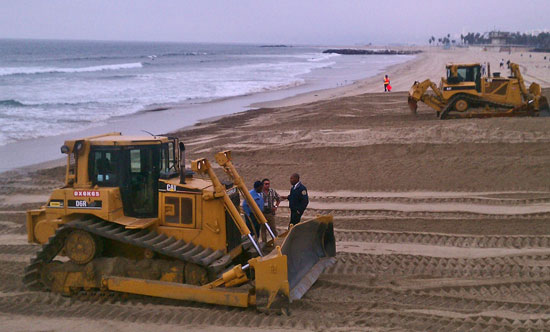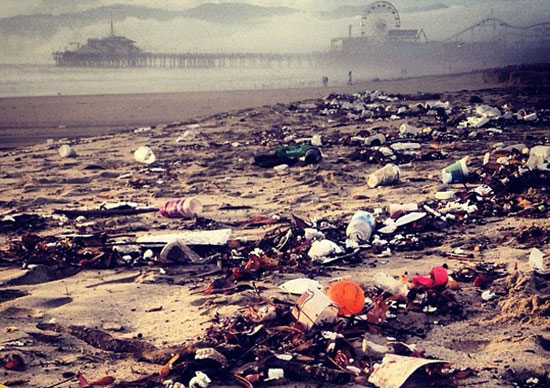Storming the beach as runoff flows
December 6, 2012
The first storm of a Southern California winter can be welcome and even romantic. Not so the aftermath—or as clean-up crews at the beach wryly call it, “The First Flush.”
“Those big storms really clean out the creeks and the catch basins,” says Carlos Zimmerman, assistant chief in the facilities and property maintenance division at the county Department of Beaches & Harbors, and a 33-year employee of the department. “Everything washes down—trees, bushes, firewood, plastic bottles, foam containers. Tons and tons of trash. Dead dogs and cats. Snakes. All kinds of things, you wouldn’t believe it. I saw a BMW come out of Topanga Creek once.”
That’s why, as rainstorms pelted Southern California last weekend, county and municipal crews were hitting the beaches to clean up debris. Their efforts are just one of the ways—from pending litigation to an upcoming Clean Water, Clean Beaches ballot measure—in which runoff will be front and center this winter in Los Angeles County
“Things like education efforts and ordinances against single-use plastic bags and polystyrene containers are making inroads, but it’s obviously an extreme problem,” notes Kirsten James, water quality director at Heal the Bay, the environmental advocacy organization.
Debris, she notes, is just the most visible pollution that courses into the ocean after a rainstorm. (This is one reason why health officials recommend staying out of the ocean for 72 hours after a rainstorm.)
“Heavy metals and bacteria are in there as well,” James says. “Some years, [the First Flush] looks like you’re not even in a First World country—more like you’re at a dump than at the beach.”
Kerry Silverstrom, chief deputy director at Beaches & Harbors, says that county beaches get runoff from more than 200 storm drains, as well as from Ballona Creek, which dumps runoff from miles inland into Santa Monica Bay. Though “trash catchers” installed throughout the system in recent years are intercepting more and more garbage, some still is making it down to the shoreline. Because storm water often continues to flow long after a heavy rainfall, and the debris it carries can churn on the waves for days before being washed up by high tide, the cleanup after a storm usually lasts long after the clouds part.
“That was one of the surprises when I first came to Beaches & Harbors,” says Silverstrom. “I had no idea that there was as much winter work on the beaches as summer work.”
That winter work, done by year-round maintenance crews, can mean anything from tending beach restrooms to piling sandbags to pulling lifeguard towers back from the pounding surf. Kenneth Foreman, chief of the department’s facilities and property maintenance division, says nearly 80 county workers were deployed at a dozen coastal beaches after last weekend’s rain storms, from equipment operators with sand-sanitizing machinery to hand crews who walked the high-tide line, plucking scraps of litter.
The winter crews, he adds, start at 6 a.m. and work every day, rain or shine, including weekends. “We worked Saturday and Sunday, even though it was storming,” he says. “Often by the time the general public hits the beach, they have no idea how dirty it was before they got there.”
There are things the public can do to help limit beach pollution, from proper disposal of motor oil and animal waste to keeping trash out of the storm drains to letting local stormwater coordinators know if flooding occurs in your neighborhood from trash-clogged catch basins.
On a longer-term level, the Board of Supervisors will conduct a January 15 public hearing on whether to seek property owner approval of the Clean Water, Clean Beaches measure through a mail-in ballot. The measure, prompted in part by toughened federal clean water standards, would raise $270 million for stormwater projects in Los Angeles County by assessing parcel owners based on the amount of runoff they generate (about $54 a year for a typical single-family residence.)
Meanwhile, cleanup crews will be fighting the good fight on a landscape that, when the storms hit, still too often becomes long on odor and short on scenery. At a Santa Monica city beach near the Pico/Kenter storm drain, a Heal the Bay staffer blogged last Friday morning that the sight and stench were “shocking.”
“I . . . saw runoff flowing fast out onto the Santa Monica beach, carrying along with it strong smells reminiscent of motor oil and gasoline, hundreds of plastic cups, chip bags, soda cans, an unusually high number of tennis balls, plastic bags (some full of pet waste), bits of Styrofoam, bottle caps, and more urban detritus,” blogged interactive campaigns manager Ana Luisa Ahern, who posted some haunting pre-cleanup photos on the organization’s web site.
“It was a saddening and somber sight, to say the least.”

Kenneth Foreman Sr. of Beaches & Harbors, in jacket at far right, hits the sand after last weekend's storms.
Posted 12/6/12













 405 bridge work causes a stink
405 bridge work causes a stink
